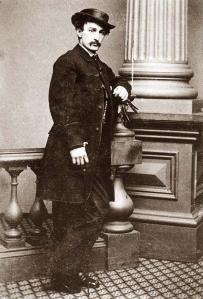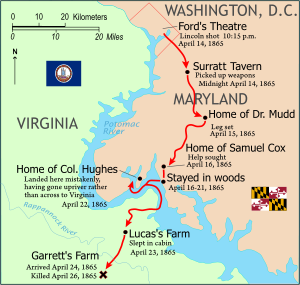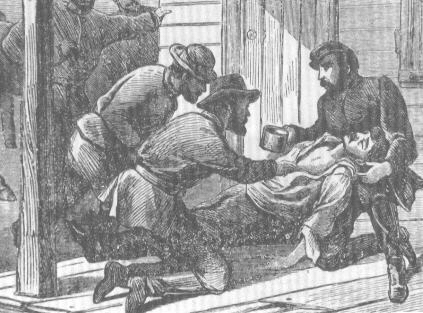
John Wilkes Booth assassinates President Abraham Lincoln at Ford's Theater in Washington, D.C., on April 14, 1865. The Confederacy had fallen five days earlier.

John Wilkes Booth, assassin of President Lincoln, 1838-1865. Born into a famous acting family, his father named him after an English rebel and encouraged in him an anti-establishment nature.
For 12 days, Lincoln assassin John Wilkes Booth was a fugitive, successfully eluding Union manhunters who were combing the countryside south of Washington, D.C., in search of him. With a painful broken left leg, Booth rode and walked through Maryland, rowed across the Potomac River, and landed in Virginia. He hid in underbrush, Confederate safe houses, and pine thickets. But time was running out on him when he reached Virginia’s shores. Booth had committed the most foul crime, the murder of our president. Abraham Lincoln had been dead for 11 days then. The country was plunged into deep mourning. The people -from both the North and South – agitated for justice. The Union manhunters hot on Booth’s trail were not turning back, not until they’d brought in their prey – dead or alive.
They finally caught up with Booth and his assassination coconspirator Davey Herold at 2 a.m. on April 26, 1865. Union cavalry surrounded a tobacco barn at Richard Garrett’s farm outside Port Royal, Virginia, where Booth and Herold were inside sleeping. They were 60 miles south of Ford’s Theater in Washington.

Booth's escape route
Herold quickly surrendered, marching out of the barn and submitting to being tied to a tree. But Booth refused to come out of the barn. Gathering straw and brush, the soldiers set the barn on fire. Still Booth would not surrender. Through knotholes and cracks in the barn’s walls, the soldiers watched him moving around inside the barn, hobbling around on a crutch, holding a carbine. By sunrise, though, Booth was dead, killed by a shot fired through his neck by soldier Boston Corbett aiming through the barn walls and acting on his own accord. Booth did not die instantly but lingered near death lying on the grass near a locust tree. He was later moved to the porch of the Garrett farmhouse, where he died.

Lincoln assassin John Wilkes Booth was pronounced dead at 7:15 A.M. April 26, 1865. After his death, a search of his body turned up a pair of revolvers, a belt and holster, a knife, some cartridges, a file, a war map of the Southern states, a spur, a pipe, a Canadian bill of exchange, a compass with a leather case, a signal whistle, an almost burned-up candle, photos of five women - four actresses (Alice Grey, Helen Western, Effie Germon, and Fanny Brown) and his fiancée, Lucy Hale (the daughter of ex-Senator John P. Hale from New Hampshire), and an 1864 date book kept as a diary.
By 8:30 a.m., Booth’s limp body was sewn into a horse blanket, placed on a plank serving as a stretcher, and loaded onto a wagon that was then driven to Belle Plain. From there, it was loaded onto a steamship then a tugboat and transported up the Potomac to the Washington Navy Yard. There it was transferred to the anchored ship, the Montauk. Booth’s remains were laid on a bench. The horse blanket was removed, and a tarp was placed over the corpse. Many witnesses were gathered to identify the body:

One of these people was Dr. John Frederick May. Some time prior to the assassination, Dr. May had removed a large fibroid tumor from Booth’s neck. Dr. May found a scar from his operation on the corpse’s neck exactly where it should have been. Booth’s dentist, Dr. William Merrill, who had filled two teeth for Booth shortly before the assassination, pried open the corpse’s mouth and positively identified his fillings.
Charles Dawson, the clerk at the National Hotel where Booth was staying, examined the remains, saying “I distinctly recognize it as the body of J. Wilkes Booth – first, from the general appearance, next, from the India-ink letters, ‘J.W.B.,’ on his wrist, which I had very frequently noticed, and then by a scar on the neck. I also recognize the vest as that of J. Wilkes Booth.” …Seaton Munroe, a prominent Washington attorney who knew Booth, viewed the body and said that he “was very familiar with his (Booth’s) face and distinctly recognize it.” Alexander Gardner, a well-known Washington photographer, and his assistant, Timothy H. O’Sullivan, were also among those called to the Montauk to identify Booth’s corpse. (1)
As for the tattoo, it was on John Wilkes Booth’s left hand. His sister, Asia Booth Clarke, wrote about it in her published memoirs, The Unlocked Book, John Wilkes Booth, a Sister’s Memoir. Asia felt her brother possessed both great charm and physical beauty, including his hands:
“He had perfectly shaped hands, and across the back of one he had clumsily marked, when a little boy, his initials in India ink.” (2)
Though innocent of any crime, Asia’s husband was one of a hundred people rounded up and imprisoned after the Lincoln assassination, implicated by association with John Wilkes Booth. After her husband’s release from jail and exoneration from criminal activity, Asia, her husband, and their children (8 total, 2 of whom became actors) emigrated to England, away from the unwanted notoriety brought about by her brother’s heinous crime.
(1) Abraham Lincoln’s Assassination
(2) Steers, Edward, Jr. Blood on the Moon. Lexington: University Press of Kentucky, 2001.
























